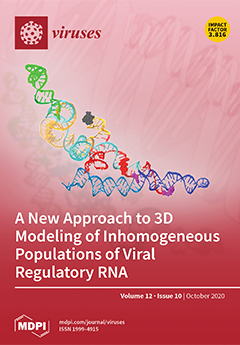Open AccessArticle
Frequency and Duration of SARS-CoV-2 Shedding in Oral Fluid Samples Assessed by a Modified Commercial Rapid Molecular Assay
by
Licia Bordi, Giuseppe Sberna, Eleonora Lalle, Pierluca Piselli, Francesca Colavita, Emanuele Nicastri, Andrea Antinori, Evangelo Boumis, Nicola Petrosillo, Luisa Marchioni, Giulia Minnucci, Elena D’Agostini, Concetta Castilletti, Franco Locatelli, Alimuddin Zumla, Giuseppe Ippolito, Maria Rosaria Capobianchi and on behalf of INMI ReCOVeRI Study Group
Cited by 17 | Viewed by 6467
Abstract
Background: RT-PCR on nasopharyngeal (NPS)/oropharyngeal swabs is the gold standard for diagnosis of SARS-CoV-2 infection and viral load monitoring. Oral fluid (OF) is an alternate clinical sample, easy and safer to collect and could be useful for COVID-19 diagnosis, monitoring viral load and
[...] Read more.
Background: RT-PCR on nasopharyngeal (NPS)/oropharyngeal swabs is the gold standard for diagnosis of SARS-CoV-2 infection and viral load monitoring. Oral fluid (OF) is an alternate clinical sample, easy and safer to collect and could be useful for COVID-19 diagnosis, monitoring viral load and shedding. Methods: Optimal assay conditions and analytical sensitivity were established for the commercial Simplexa™ COVID-19 Direct assay adapted to OF matrix. The assay was used to test 337 OF and NPS specimens collected in parallel from 164 hospitalized patients; 50 bronchoalveolar lavage (BAL) specimens from a subgroup of severe COVID-19 cases were also analysed. Results: Using Simplexa™ COVID-19 Direct on OF matrix, 100% analytical detection down to 1 TCID50/mL (corresponding to 4 × 10
3 copies (cp)/mL) was observed. No crossreaction with other viruses transmitted through the respiratory toute was observed. Parallel testing of 337 OF and NPS samples showed highly concordant results (κ = 0.831; 95 % CI = 0.771–0.891), and high correlation of Ct values (r = 0.921;
p < 0.0001). High concordance and elevated correlation was observed also between OF and BAL. Prolonged viral RNA shedding was observed up to 100 days from symptoms onset (DSO), with 32% and 29% positivity observed in OF and NPS samples, respectively, collected between 60 and 100 DSO. Conclusions: Simplexa™ COVID-19 Direct assays on OF have high sensitivity and specificity to detect SARS-CoV-2 RNA and provide an alternative to NPS for diagnosis and monitoring SARS-CoV-2 shedding.
Full article
►▼
Show Figures






